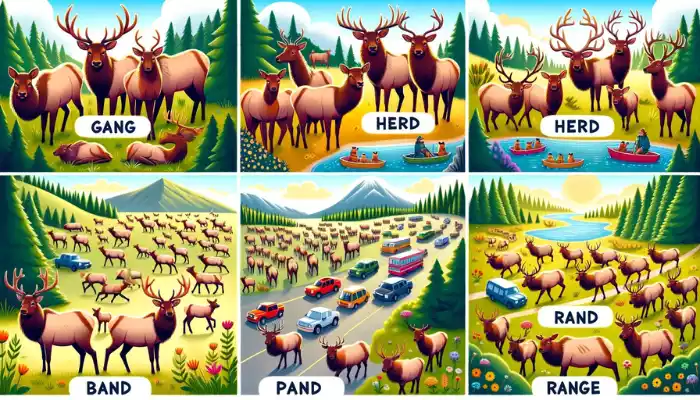Welcome to our educational journey through the fascinating world of collective nouns focusing today on elks Collective nouns are special words we use to describe a group of the same kind of animals people or things. They make our language more colourful and descriptive. Imagine saying a bunch of elks versus a gang of elks the second option paints a much more vivid picture.
Table of Collective Noun for Elks
| Collective Noun | Definition | Example |
|---|---|---|
| Gang | A group of elks | A gang of elks was spotted in the forest. |
| Herd | A large group, typically of animals | A herd of elks migrated across the plains. |
| Parade | An orderly group moving together | A parade of elks crossed the road at dawn. |
| Band | A group of animals | A band of elks grazed in the meadow. |
| Range | A group roaming over a large area | A range of elks was seen in the national park. |
Detailed Explanations and Examples for Elks
1. Gang of Elks
Explanation: The term gang often refers to a group of elks moving or feeding together in the wild. It suggests a close-knit group roaming the forests or plains.
Examples:
- The hikers quietly observed a gang of elks drinking by the lake.
- In the early morning mist, a gang of elks could be seen grazing.
- Photographers captured the majestic sight of a gang of elks through their lenses.
2. Herd of Elks
Explanation: Herd is a common term for a large group of animals of the same species. It implies a social structure and is often used for elks living in open areas.
Examples:
- A herd of elks moved slowly through the snow-covered valley.
- The sound of a herd of elks calling to each other filled the air.
- Children at the national park were thrilled to see a herd of elks up close.
3. Parade of Elks
Explanation: A parade of elks conveys an image of elks moving in an orderly, impressive manner, often during migration or when crossing a visible area.
Examples:
- Visitors stopped their cars to watch a parade of elks cross the road.
- A parade of elks was the highlight of our safari in the wilderness.
- The parade of elks against the backdrop of the setting sun was a sight to remember.
4. Band of Elks
Explanation: The term band refers to a smaller group of elks, possibly a subset of a larger herd, that stays together for social or feeding reasons.
Examples:
- A band of elks was spotted resting under the trees.
- During the fall, a band of elks can often be seen in the meadow.
- The band of elks seemed unfazed by the nearby hikers.
5. Range of Elks
Explanation: Range suggests a group of elks that has a wide area to roam. It highlights the elks’ need for extensive natural habitats.
Examples:
- A range of elks is a common sight in the larger national parks.
- Conservation efforts aim to secure the habitats for the range of elks.
- The ranger explained the migration patterns of the range of elks in the area.
Quiz Time!
1. What term describes a large group of elks living in open areas?
- A) Gang
- B) Parade
- C) Herd
- D) Band
2. Which collective noun suggests a group of elks moving in an impressive manner?
- A) Herd
- B) Band
- C) Parade
- D) Range
3. What does the term band refer to when talking about elks?
- A) A large group migrating together
- B) A group roaming over a large area
- C) A smaller group within a larger herd
- D) An impressive movement of elks
4. Which collective noun is used for a group of elks that has a wide area to roam?
- A) Gang
- B) Parade
- C) Band
- D) Range
Answers to Quiz
- C) Herd
- C) Parade
- C) A smaller group within a larger herd
- D) Range
Conclusion
Collective nouns for elks, such as gang, herd, parade, band, and range, enrich our language and help us describe the natural world with more precision and beauty. Each term brings to life the different aspects and behaviours of elks in the wild. Remembering these collective nouns not only boosts our vocabulary but also our appreciation for these majestic creatures and their habitats.

